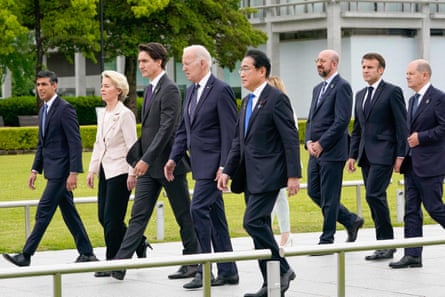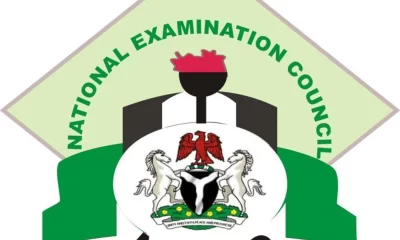Top Stories
G7 leaders confront spectre of nuclear conflict on visit to Hiroshima memorial

G7 leaders have laid flowers at a memorial to the victims of the US atomic bombing of Hiroshima in a sombre opening to a summit overshadowed by fears of a potential nuclear conflict in Ukraine.
As the heavy early morning rain began to ease, the summit’s host, Japanese prime minister Fumio Kishida, and his wife, Yuko, welcomed leaders and their spouses at the entrance to the city’s Peace Memorial Museum, where they viewed graphic reminders of the attack on the city on 6 August 1945 and its gruesome aftermath.

The Japanese leader – whose wife wore a gold pin shaped like an origami crane, a symbol of the city’s nuclear legacy – has said that achieving a world free of nuclear weapons is his “life’s work”.
Joe Biden became the second sitting US president to visit Hiroshima, after Barack Obama in 2016, while Rishi Sunak is the first British prime minister to visit the site of the world’s first nuclear attack. An estimated 60,000 to 80,000 people died instantly, but by the end of the year, the death toll had risen to 140,000 as more succumbed to burns and illnesses caused by exposure to radiation.
Media were barred from the museum for the length of the visit – amid speculation over whether the leaders would visit only the building’s east wing, which describes the dangers of nuclear war, or also pass through the main building, which contains photos of victims with horrific injuries.
The group emerged from the museum after about 30 minutes and, led by Kishida and Biden, made the short walk to a cenotaph honouring the 333,907 people whose deaths have been attributed to the atomic bombing almost eight decades ago.
Together, the leaders stepped forward to lay wreaths – given to them by local schoolchildren – on podiums in front of the memorial, with its eternal flame and plaque that reads: “Let all the souls here rest in peace, for we shall not repeat the evil.”
The burned-out shell of the A-bomb Dome, one of the few buildings to have survived the attack, could be seen in the distance. After a moment of silence, there was a group ceremony to plant a cherry blossom sapling, propagated from a tree that survived the atomic blast. The leaders later met a hibakusha survivor of the bombing.
On a morning steeped in symbolism, this was the first time the leaders of G7 countries – including three that possess nuclear weapons – had visited the museum together.
US officials said Biden, in a repeat of the approach taken by Obama, did not plan to issue an apology – a move that would go down badly in the US, where the atomic bombings of Hiroshima and, three days later, Nagasaki are seen as bringing the Pacific war to a quick end.
But he and the other leaders viewed some of the museum’s harrowing exhibits, which included burned and ripped clothes, the charred contents of a child’s lunch box and strands of human hair from people who suffered exposure to radiation.
Kishida, who represents a constituency in Hiroshima, said agreements on the need to realise a world without nuclear weapons were among his goals during the three-day summit, which is expected to be dominated by the war in Ukraine and China’s growing military and economic might.
“We will once again confirm our resolve to work for a world without nuclear weapons and we hope to transmit to the world our strong determination to protect the free and open international order based on the rule of law,” Kishida told reporters as he left for Hiroshima.
“I hope that here in Hiroshima, the G7 and leaders from elsewhere will show their commitment to peace, which will be remembered in history.”
In keeping with Kishida’s desire to place nuclear weapons high on the agenda, the summits final communique is expected to criticise Russia for threatening to use tactical nuclear weapons in Ukraine.
Obama, who won the Nobel peace prize for his vision of a world without nuclear weapons, gave a speech at the peace park in 2016 and embraced a hibakusha survivor of the atomic bombing. But he spent only 10 minutes in the museum’s lobby, where he was shown a small number of symbolic exhibits.
Kishida has tried to move nuclear disarmament up the agenda for this year’s summit and reportedly insisted G7 leaders visit not only peace memorials but also the museum.
“I believe the first step toward any nuclear disarmament effort is to provide a first-hand experience of the consequences of the atomic bombing and to firmly convey the reality,” he said ahead of the visit to the peace museum.
There is little enthusiasm for reducing nuclear stockpiles, however, at a time when Russia has issued thinly veiled threats to use them against Ukraine, and while North Korea is raising fears of a new nuclear test after a series of long-range missile launches.


 News12 hours ago
News12 hours agoBlack Market Dollar (USD) To Naira (NGN) Exchange Rate Today 16th April 2024

 Top Stories6 hours ago
Top Stories6 hours agoBREAKING: Tinubu Govt Begins Disbursement Of N200 Billion Grants

 Entertainment9 hours ago
Entertainment9 hours agoJunior Pope: Remains Of Late Make-Up Artist Buried In Akwa Ibom

 Top Stories9 hours ago
Top Stories9 hours agoNigeria’s Crude Oil Reserves Hit 37.50 Billion Barrels – NUPRC

 News6 hours ago
News6 hours agoNECO Reschedules Common Entrance Exam Into Unity Colleges








